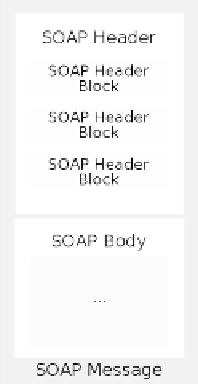Global Positioning System Reference
In-Depth Information
that consists of three parts: an envelope that defi nes a framework
for describing what is in a message and how to process it, a set
of encoding rules for expressing instances of application-defi ned
data types, and a convention for representing remote procedure
calls and responses.'
(Gudgin et al. 2001)
SOAP main design goals are simplicity and extensibility and, although
it can be potentially used in conjunction with any type of transport protocol,
currently the only widely used binding is the HTTP protocol. In general,
SOAP enables different platforms to communicate each other thus allowing,
for example, Web services implemented with Java platform and Web services
implemented with Microsoft .NET platform to seamlessly communicate.
Being completely XML based, it heavily relies on its standards, like XML
Schema and XML namespaces for data type defi nitions and messages
syntax.
SOAP messages are fundamentally one-way transmissions from a
sender to a receiver, which can be also combined to implement more
complex communication patterns, either synchronous (e.g., Request /
Response) or asynchronous (e.g., Fire and Forget). Figure 2 illustrates the
general structure of a SOAP message, which comprehensively refers to these
three basic components: an Envelope, a Header and a Body.
The Envelope is the top-level element and can be seen as the container
of the message itself. An Envelope can contain an optional Header fi eld but
has to contain exactly one Body fi eld. A Header, if present, must necessarily
appear before the Body.
Fig. 2.
The general structure of a SOAP message (Source: www.w3.org).

Search WWH ::

Custom Search